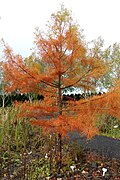Glyptostrobus pensilis
| Glyptostrobus pensilis | |
|---|---|

| |
| Scientific classification | |
| Kingdom: | Plantae |
| Clade: | Tracheophytes |
| Clade: | Gymnospermae |
| Division: | Pinophyta |
| Class: | Pinopsida |
| Order: | Cupressales |
| Family: | Cupressaceae |
| Genus: | Glyptostrobus |
| Species: | G. pensilis
|
| Binomial name | |
| Glyptostrobus pensilis | |
Glyptostrobus pensilis, known in Chinese as 水松 (Shuǐ sōng), and also Chinese swamp cypress, is an endangered conifer, and the sole living species in the genus Glyptostrobus.
Description
[edit]It is a medium-sized to large tree, reaching 30 m (98 ft) tall and with a trunk diameter of up to 1 m (3.3 ft), possibly more. The leaves are deciduous, spirally arranged but twisted at the base to lie in two horizontal ranks, 5–20 mm (0.20–0.79 in) long and 1–2 mm (0.039–0.079 in) broad, but 2–3 mm (0.079–0.118 in) long and scale-like on shoots in the upper crown. The cones are green maturing yellow-brown, pear-shaped, 2–3 cm (0.79–1.18 in) long and 1–1.5 cm (0.39–0.59 in) diameter, broadest near the apex. They open when mature to release the small, 5–20 mm (0.20–0.79 in) long, winged seeds. Like the related genus Taxodium, it produces 'cypress knees', or pneumatophores, when growing in water, thought to help transport oxygen to the roots.
Distribution and habitat
[edit]G. pensilis is native to subtropical southeastern China, from Fujian west to southeast Yunnan, and also very locally in Central Vietnam and down to central Laos, where stands exist in the Nakai-Nam Theun area.[3] It typically grows in river banks, ponds and swamps, growing in water up to 60 cm (24 in) deep.
Conservation
[edit]The species is nearly extinct in the wild due to overcutting for its valuable decay-resistant, scented wood, but it is also fairly widely planted along the banks of rice paddies where its roots help to stabilise the banks by reducing soil erosion.[4] There appear to be no remaining wild plants in China and few of those in Vietnam are seed-bearing.[5] A population of Chinese swamp cypress was recently discovered in central Laos.[3] The species is found in several botanical gardens around the world.[6] It was previously reported that there were four specimens of this tree growing in Bank Hall Gardens, Lancashire, United Kingdom, but it has now been confirmed that they are in fact the swamp or bald cypress from the southeastern USA, Taxodium distichum.
Remarkable Specimens
[edit]The largest known cultivated tree is located at the Christchurch Botanic gardens in New Zealand. The tree measures 25.20 m (82.67 ft) tall, 12.3 m (40.3 ft) wide and 3.21 m (10.53 ft) in girth.[7]
Gallery
[edit]-
Unripe cone
-
Ripe cones
-
Seedling in the Coastal Georgia Botanical Gardens, US
-
Young tree in the Oregon Garden in autumn; it is deciduous
-
Close-up of autumn foliage
-
A wet environment
-
400- to 500-year-old trees in Nanhua Temple
-
Bark of trunk
References
[edit]- ^ Thomas, P.; Yang, Y.; Farjon, A.; Nguyen, D.; Liao, W. (2020). "Glyptostrobus pensilis". IUCN Red List of Threatened Species. 2020: e.T32312A177795446. doi:10.2305/IUCN.UK.2020-3.RLTS.T32312A177795446.en. Retrieved 19 November 2021.
- ^ "Glyptostrobus pensilis". Germplasm Resources Information Network. Agricultural Research Service, United States Department of Agriculture. Retrieved 2009-10-14.
- ^ a b McGuire, D. (28 May 2015). Saving the Endangered Chinese Swamp Cypress. Earth Island Journal. Retrieved 15 June 2019.
- ^ Fu, Liguo; Yu, Yong-fu; Adams, Robert P.; Farjon, Aljos. "Glyptostrobus pensilis". Flora of China. Vol. 4. Retrieved 2013-12-09 – via eFloras.org, Missouri Botanical Garden, St. Louis, MO & Harvard University Herbaria, Cambridge, MA.
- ^ "Another leap towards the Barometer of Life". International Union for the Conservation of Nature. 10 November 2011. Archived from the original on 12 December 2013. Retrieved 9 December 2013.
- ^ Gymnosperm Database: Glyptostrobus. Retrieved 15 June 2019.
- ^ "Tree Information". The New Zealand Tree Register. Retrieved 17 June 2024.









